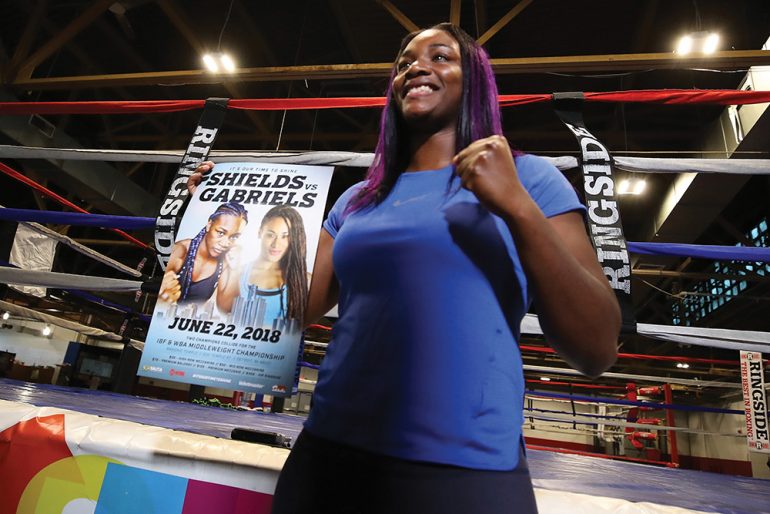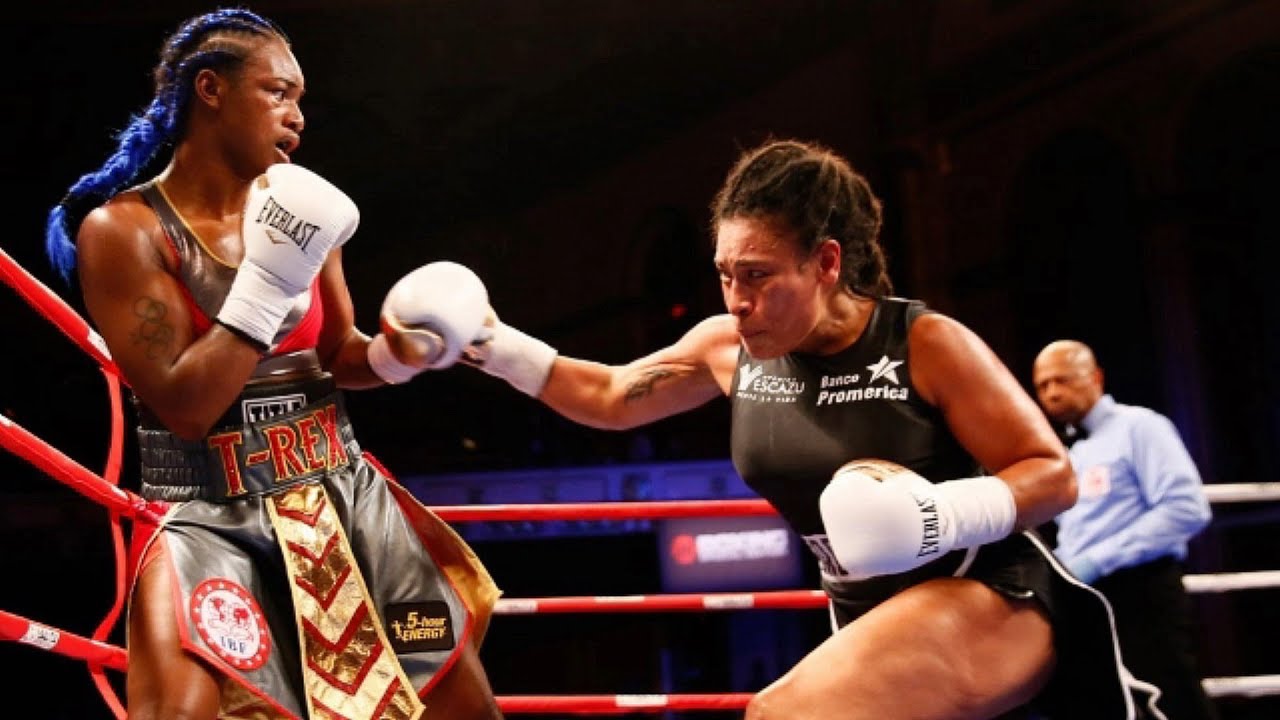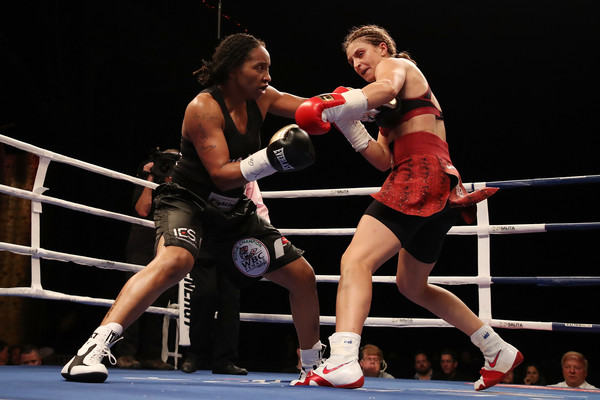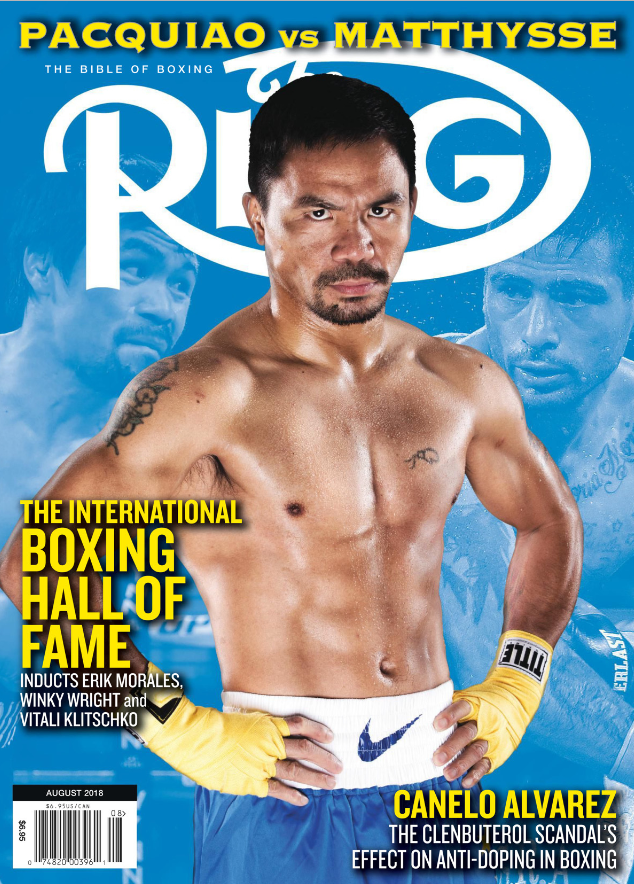The Travelin’ Man returns to Detroit: Part two

Please click here to read Part Two.
Friday, June 22 (continued): As undefeated IBF/WBC super middleweight titlist Claressa Shields strode toward the ring inside Detroit’s Masonic Temple, she knew everything that had transpired over the past few years was leading up to this point in her life. The gold medals in back-to-back Olympics and the five dominant wins as a pro established the foundation for Shields to start fulfilling the visions and responsibilities laid out for her: Revive boxing in her home state of Michigan, become the face and the financial focal point of women’s boxing (especially in the U.S. marketplace) and prove she has the ingredients and intangibles to back up her Muhammad Ali-like boast of being boxing’s “GWOAT” (“Greatest Woman of All Time”).
Standing across the ring from her was WBA/WBO junior middleweight beltholder Hanna Gabriels, by far the best opponent Shields had faced in her entire boxing life – amateur or pro. The 35-year-old from Costa Rica had won titles at 147 and 154, thanks to her outstanding mobility and punching technique, and throughout the promotion she radiated the regal bearing of an experienced champion who fully expected to vaporize the Shields juggernaut in her opponent’s home state.
And just 72 seconds into the first round, Gabriels had taken a big step toward doing just that.
A right uppercut drove Shields (6-0, 2 knockouts) to a sitting position on the canvas. As the crowd screamed in shock, Shields glanced down to her right, took a deep breath and calmly regained her feet before referee Gerard White counted “four.” Though her face registered chagrin, her eyes – and her mind – were crystal clear. For the first time in years, Shields would be asked to demonstrate more than physical superiority; she would have to prove she had the wherewithal to address and conquer real adversity inside the ring. Her difficult life beyond the ropes suggested she was more than equipped to handle stress but did she have the poise to navigate through the on-the-spot danger that confronted her?
At first, she approached the task cautiously. No longer was she charging in recklessly, with fists churning indiscriminately; she backed toward the neutral corner pad and calmly slipped an overhand right and a left hook. Then a few seconds later, she received a time-out to replace the mouthpiece that had fallen out during the knockdown. The round ended moments later with a furious two-way rally that saw Shields throw the final punch, a left hook she stopped in midair upon the sounding of the bell.
For the first time in 32 professional rounds – and for the first time in 44 rounds stretching back to the start of the Rio Olympics – an opponent had out-landed Shields, in terms of total punches (14-9) and in power connects (13-8). Gabriels (18-2-1, 11 KOs) also threw more punches (51-45 overall, 44-32 power) and did so at a higher percentage (28%-20% overall, 30%-25% power). For Shields, it was a brand new world and she had less than a minute to adjust to it.
“Take your time and relax,” trainer John David Jackson told Shields. “You’re too anxious. Take your time. Work your jab; cut the ring off and go to the body. Use those feints, OK? She’s trying to sucker you in; she’s bouncing. Put that jab downstairs, then upstairs. Don’t look for that long right hand; step in with that short right hand we talked about.”
By remaining calm and analytical, he helped Shields remain focused on the task, which, in her mind, was vengeance.
“I’ve never been knocked down before but I know, once I hit the ground, I took a deep breath, and I remember thinking to myself, ‘I’m about to whoop this girl’s ass!’”
Her quote transported me back to 1992, when I interviewed future Hall-of-Famer Danny “Little Red” Lopez, and his trainer/manager Benny Georgino, for a story that appeared in the September 1991 issue of THE RING Magazine. Lopez had suffered numerous knockdowns early in his fights and, every time, he wanted nothing more than to do the same to his antagonist, as soon as possible.
“(Getting knocked down) actually stirred me up and infuriated me,” Lopez said. “I’d think, ‘Who is this guy to knock me down?’ All those times I got knocked down and jumped back up, I was never really hurt or dazed. Like when I fought Ruben Olivares at the Forum. I didn’t even feel the punch that knocked me down. Sure, I looked at the films and I saw the knockdown but I didn’t even feel it. So Olivares comes jamming in to try and knock me out and – boom – I got him because I wasn’t hurt. The thing that went through my mind was to just get up and get that knockdown back.”
“Nobody had the heart of Danny Lopez,” Georgino said then. “(The knockdowns he suffered) touched a button on him and increased his incentive to come back and knock the other guy down. I would see his feet after he got knocked down, and he would start moving them like, ‘OK, let’s get going. I gotta get you outta here now.’”
In round two, Shields got back on track. She upped her output from 45 to 63 punches – which was in line with the 66.5 she averaged in her other pro fights – and she out-landed Gabriels 17-11 overall as well as 13-8 in power shots. She also was more accurate (27%-22% overall, 33%-21% power) and she worked her jab better, as he upped her count from 1 of 13 in the first to 4 of 24 in the second. Yes, Gabriels was still firing back hard – she threw 51 punches and equaled Shields with 39 attempted power punches – but, for Shields, a measure of normalcy had returned.

Undefeated two-division female middleweight titlist Claressa Shields (left) vs. WBA/WBO junior middleweight beltholder Hanna Gabriels. Image courtesy of YouTube.
Except for a small cut on her left cheek that she picked up in the final round, Shields maintained control throughout the rest of the contest – though it wasn’t easy. She out-landed Gabriels, in terms of total connects in every round going forward, while doing the same in power connects until the final round, in which Gabriels edged Shields 16-15. The pace was robust, and, somewhat surprisingly, Gabriels out-threw Shields 510-506. But because Shields was more accurate overall (32%-25%), and in power punches (42%-26%), she wound up with connect leads of 162-133 overall, 33-26 jabs and 129-107 power. Gabriels was the much better body puncher (she led 53-14) and she finished the fight on a strong note by throwing 71 in the ninth and 66 in the 10th, compared to 59 and 57 for Shields.
In defeat, Gabriels did herself proud. She forced Shields to dig deeper than she ever had to, and she showed Shields what it was like to fight someone with a champion’s mentality – an experience Shields will find useful a few months down the road. Gabriels landed more punches on Shields (133) than any previous opponent by far (Nelson landed 81), and she rewrote the record book, in terms of opponent success (71 attempted punches and 20 total connects in round nine, 59 power attempts and 16 landed power shots in round 10, the most jabs thrown and landed in a fight, the most power punches thrown and attempted in a fight and the most jabs landed in a single round with five in round eight).
As for Gabriels’ future, she definitely has one in the U.S. market. Her skill set and her pleasing personality would be most welcome on future telecasts in America – and everywhere else, for that matter.
*
While watching the fight from the back of the arena, Showtime’s cameras caught Shields, who won the vacant WBA and newly-created IBF middleweight titles against Gabriels, saying, “She’s even slower in person.” The “she” Shields was speaking about was WBC/WBO middleweight titlist Christina Hammer, who looked lightning quick in outpointing Tori Nelson over 10 fast-paced rounds.
Hammer (23-0, 10 KOs) looked at this fight as an opportunity to sell the U.S. market on her worthiness as a champion, as well as an excellent antagonist for Shields. This she did, with emphasis. Hammer smartly exploited her height and reach advantages (five inches and seven inches respectively) by keeping the fight at long range but moving inside just often enough to win the majority of the exchanges. Her typically excellent jab landed with frequency, and with heavier force than in past fights, and her right hands connected with enough impact to make the point but not enough to upend the sturdy 41-year-old.

Undefeated WBC/WBO female middleweight titleholder Christina Hammer (right) vs. Tori Nelson. Photo credit: Getty Images
Statistically speaking, Hammer was superb: Averaging 46.6 punches per round, while limiting Nelson (17-2-3, 2 KOs) to 31.8, she prevailed 103-56 overall, 44-18 jabs and 59-38 power. The accuracy figures were sub-par (22% overall, 19% jabs, 26% power) but her defensive skills limited Nelson to just 18% overall, 16% jabs and 19% power. Also with the fight already in hand, Hammer throttled down from 53 punches in round nine (a round in which she out-landed Nelson 13-2) to 36 in the 10th (in which they tied with six total connects).
In terms of using Nelson to claim superiority over Shields, Hammer came away with a mixed bag, at best. Yes, Nelson landed fewer punches on Hammer (56) than on Shields (81) but Shields landed many more punches on Nelson (225) than Hammer did (103). Shields hit Nelson with much more accuracy (36% overall, 44% power to Hammer’s 22% and 26% respectively), and with more impact.
Hammer and her team intently watched Shields-Gabriels at ringside, and moments after the American was declared the winner, the pair wrote the first chapter of their pre-fight build-up by engaging in a brief shoving match. While the emotions may be genuine, the act was wholly unnecessary, in terms of building anticipation for their showdown.
https://www.youtube.com/watch?v=SdoCiNyMwb4
So who do I think would win a Shields-Hammer fight? When I woke up this morning, I thought Shields would win easily because of her superior size and strength, her combination punching and her strong competitive drive. Now with the combination of Shields being floored by someone coming up from a lighter weight class and Hammer’s excellent performance against a common opponent, the competitive gap between the pair closed to the point where I see a competitive match. That said, I still believe Shields will defeat Hammer for the same reasons I listed earlier but if Hammer produces her A-plus game, she can administer a strong test of Shields’ composure and acumen. In any case, I look forward to seeing it, and maybe being ringside to count it.
The telecast kicked off with a light heavyweight match between Umar Salamov (21-1, 16 KOs) and Brian Howard (13-2, 10 KOs), which adequately set the table for the two women’s fights because it established a rather low bar, in terms of excitement. Both fighters are tall and rangy (6-foot-3½, 76-inch reach for Salamov, 6-foot-2, 75-inch reach for Howard), and both lived up to their physiques, as they produced jab-heavy offenses. Of Salamov’s 353 punches, 232 (65.7%) were jabs, while 222 of Howard’s 311 punches (71.4%) were jabs. The pace was slow (42.6 per round for Salamov, 37.5 for Howard, well below the 52.3 light heavyweight average), and, in the end, a single right hand to the temple ended matters in the ninth.
Veteran referee Sam Williams could have stopped the proceedings before reaching the count of 10 but opted not to do so.
For the record, Salamov led 90-76 overall and 41-24 power, while Howard prevailed 52-49 in landed jabs. The same dynamic applied, in terms of accuracy, as Salamov led 26%-24% overall and 34%-27% power, while Howard forged a 23%-21% edge in jab precision.
*
After having a slice of post-card pizza (when I also signed books for Raul Marquez and Mary “Queen of Stats” Swinson), Andy and I caught a ride back to the hotel with stage manager JT Townsend – to whom I passed notes for the on-air talent all evening. I then purchased a diet soda from the lobby’s mini-mart and headed upstairs to upload the four counted fights into the master database, a process that took about 45 minutes to complete. With the window before my goal wake-up time of 8:15 a.m. closing fast, I turned out the lights at 2:45 and hoped I would fall asleep quickly.
Saturday, June 23: I did, and though I awakened a few times during the night, I dozed for the final half-hour before officially arising at 8:15 a.m. I completed the morning routines, wrote my “Ali Stat of the Day” on my Facebook page – a ritual I have followed since the book’s release three-and-a-half weeks ago – packed my belongings and checked out of the hotel in the hope that the 9:15 a.m. taxi would arrive on time.
As I was finishing my packing, my hotel room phone unexpectedly rang. Thoughts raced through my mind as I approached the phone: Was this call from home? And if it was, would it be about bad news?
It was neither. It was the front desk informing me that my taxi had just arrived. Not only was it on time, it was eight minutes early.
Not only was my driver a fellow early bird, he was also a lead foot. As a result, we arrived at DTW just 15 minutes after leaving the hotel.
I passed through security with ease – this time I took out one of the laptops – and I broke with routine by actually having breakfast. A large breakfast.
I’ve never been a breakfast person. My mild aversion to eating early in the day was developed in childhood, when I had to choke down food before leaving for school or else be hungry at 9:30 a.m., and deal with my rumbling stomach for the next two-and-a-half hours. Once I left for college, I adopted my own eating schedule – lunch, dinner, late-night snack – and have stuck to it ever since. I simply do not get hungry until I’ve been awake for at least three hours.
But for some reason, I was in the mood for some breakfast food, and after bypassing a McDonald’s outlet, I decided to stop by a diner called Max and Erma’s. Before committing to eating there, I perused the menu, found something appetizing and requested a table.
As I scanned the menu one more time, I thought of the “Original Travelin’ Man” Jack Obermayer, who passed away a couple of years ago. He often wrote about his countless stops at out-of-the-way diners, and the adventures he experienced along the way, and, as informative (and snarky) as his fight stories were, I enjoyed the diner stories the most. In fact, “KO JO’s” work was an inspiration for my own series of articles, which began more than 15 years ago.
For the record, I ordered two eggs over easy, bacon, four slices of toast, a small fruit bowl and a glass of orange juice. Although I was mildly hungry, I hoped the portions wouldn’t be too large for me to handle.
They weren’t. The food was good, and I deemed the service good enough to warrant a very nice tip. I appreciate the hard work servers put in, and I know how dependent they are on tips. I’ve been very fortunate in my life, so why not share a portion of it with people who put in the tough hours to make our days a little bit more pleasant?
I settled into my gate, broke out the laptop and began writing but, after a little bit, the sleepiness that comes from shorter-than-desired sleep and a nice large meal began setting in. It was hard to keep my eyes open but I managed to make it to and through the boarding process. From there, I rested my eyes for the entirety of the flight, which landed at 12:58 p.m. The rest allowed me to regain enough energy to complete the rest of my journey, which ended when I arrived home at 3:51.
With that, a long stretch of time away from home came to an end – 13 of the last 19 days, in fact. As a result, I have fallen behind on several important tasks at the Home Office but I hope that the next three weeks will allow me to complete those tasks.
As of this writing, my next trip will be to Sloan, Iowa, where, on July 20, “ShoBox: The New Generation” will feature a tripleheader topped by welterweight prospects Jaron Ennis and Armando Alvarez.
Until then, happy trails!
*
Lee Groves is a boxing writer and historian based in Friendly, West Virginia. He is a full member of the BWAA, from which he has won 16 writing awards, including two first-place awards since 2011. He has been an elector for the International Boxing Hall of Fame since 2001 and is also a writer, researcher and punch-counter for CompuBox, Inc. He is the author of Tales from the Vault: A Celebration of 100 Boxing Closet Classics (available on Amazon) and the co-author of the upcoming book Muhammad Ali: By the Numbers. To contact Groves, use the e-mail [email protected].
Struggling to locate a copy of THE RING Magazine? Try here or
Subscribe
You can order the current issue, which is on newsstands, or back issues from our subscribe page.
















